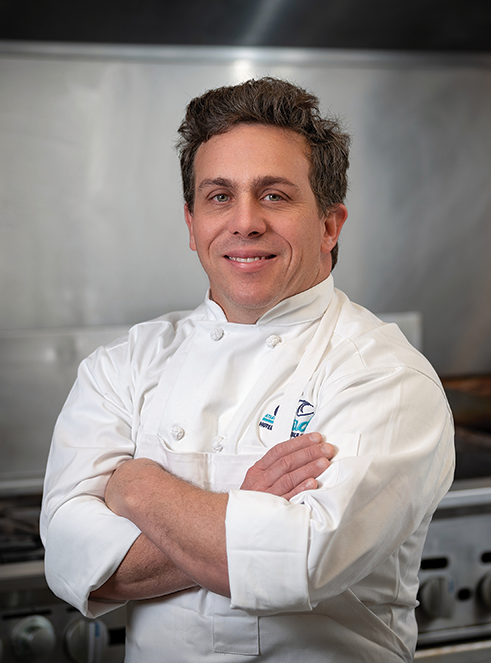Chef Jordan Lloyd shares insights and techniques to masterfully utilize a whole duck like a world-class professional—using the superior Pekin duck bred for more than 90 years by the Jurgielewicz Family.
Photography by Rebecca Smith
I first fell in love with Jurgielewicz Family Ducks when owning and operating Bartlett Pear Inn from 2008–2022. My wife Alice and I never intended a “farm to table” concept. Rather, we planned to provide our guests with the highest quality ingredients we could find—and to respect those ingredients with simple execution. To our delight, those top quality ingredients were residing in our own backyard: the Eastern Shore of Maryland and the Mid-Atlantic Chesapeake region. Jurgielewicz & Son of Pennsylvania was one of the gems we discovered.
The following is more of a technique than a recipe. I prefer to teach techniques rather than recipes because one technique can be applied to 1,000 recipes, while a recipe has just one outcome.

BREAKING THE BIRD
A duck is broken down exactly as you would a chicken. The results will yield 2 breasts for pan-searing, 2 leg/thigh pieces for confit and 2 wings and an empty carcass for the jus. YouTube offers dozens of professional videos on dividing the duck into its various parts. My advice is to keep the duck dry for ease of handling, and to complete this step one day in advance of preparations to allow the meat to dry out further. This will help to develop a nice crust when searing, and to push the flavor forward by allowing the natural moisture to evaporate slightly overnight so that the natural richness, texture and flavor of the final product are more pronounced.
DUCK LEG CONFIT
Confit is hundreds of years old and claimed by the French Gascony region. It is one of the first preservation methods, developed long before refrigeration. Today, the technique continues to be one of the most desirable preparations in the kitchens of the world’s best chefs and food enthusiasts.
Ingredients
4 duck legs
4 cups coarse sea salt
8 garlic cloves
Handful fresh thyme
1 Tbsp black peppercorn
1 bay leaf
1 qt duck fat (the size of the cooking pot determines the quantity of fat required)
Method
1. In a food processor, pulse the salt, garlic, thyme, peppercorns and bay leaf together to blend the confit preservation aromatics together.
2. In a 9×9 casserole dish, lay half of the salt mixture in the bottom of this dish. Lay two of the duck legs, skin side down, on the salt. Lay the other two duck legs, flesh side down, on the other duck flesh that is facing up, making a duck sandwich. Coat the top of the ducks with the remaining sea salt mixture. Wrap the preparation tightly with Saran wrap, with a light weight placed on top of this marinade. (Another casserole dish, the size of the one used, would be a suitable object and weight. The weight on top of this preparation will nurture the moisture out of the duck, the goal of this preservation method.) Place in the refrigerator for 24 hours.
3. The next day, unwrap the duck legs and discard all of the salt marinade.4. Heat the duck fat to 250° in a narrow pot that will hold the legs and the fat together, making sure the legs are fully covered by the fat.
4. Heat the duck fat to 250° in a narrow pot that will hold the legs and the fat together, making sure the legs are fully covered by
the fat.
5. Cover the pot with a lid. Place in an oven at a temperature of 235°.
6. Cook the duck legs until the bones are easily removable from the flesh. This will take approximately 3.5 hours.
7. Once the meat is fall-apart tender, pull the cooking pot from the oven and allow the meat to rest for 1 hour on the counter.
8. At this point, it is ready to serve or preserve. To preserve, transfer the meat and fat to a mason jar. Once the duck is fully cool, seal with the lid. The duck leg confit will remain delicious for 1 month stored in the refrigerator.
SEARING DUCK BREAST
The fat of a duck breast is one of nature’s culinary gems, bringing ecstasy to the palates it inhabits. Here are the steps to cook a proper duck breast:
Method
1. Pat the duck breasts dry.
2. Score the fat side of the duck breast using a sharp knife. Cut halfway through the fat cap in a crisscross pattern, every ¼” all the way across the breast. Season the duck breast with salt on all sides.
3. A cast iron or heavy sauté pan is best for searing the duck. Heat the pan on your stove burner to a medium heat.
4. Place the duck breast, fat side down, in the heated pan. Turn the heat to a consistent low-medium heat. Place another sauté pan on top of the duck to apply some consistent pressure to the searing process.
5. The slow searing heat will render the fat down and generate a crispy, caramelized skin. This process will take approximately 10-12 minutes. The results will be a crispy, flavorful skin that will pair perfectly with the remarkable flavors of the duck meat.
6. Once the skin is crispy and caramelized to a dark caramel color, place the duck, still skin side down, into a 325° oven. Cook the breast in the oven for 8-12 minutes depending on the size of the breast. The internal temperature should be about 118° for a perfect rare to medium rare.
7. Remove the duck breast from the oven and cooking pan. Allow the meat to rest for 10 minutes before cutting. This will help keep the duck moist and retain all of its remarkable flavors. Enjoy.
NATURAL DUCK JUS
This technique can be used for ducks, chickens, squab, turkeys, beef trimming and more.
Ingredients
1 cup duck fat (Can be the same used for the leg confit)
1 duck carcass, butchered to smaller pieces, patted dry
12-14 cloves of garlic, chopped
2 onions or 8 shallots, chopped
2 large carrots, chopped
2 celery stalks, chopped
1 leek, chopped and washed
Handful fresh thyme
1 bay leaf
¼ cup tomato paste
4 oz butter
2 cups white wine
2 tomatoes, chopped
2 qts chicken or vegetable stock
Method
1. Heat the duck fat to medium-hot in a stock pot big enough to hold all of the ingredients.
2. Add the duck carcass pieces into the hot duck fat and sear the bones until fully caramelized on all sides. The deeper and richer the caramelization, the more powerful the final flavor will be. Be careful to not over-caramelize. This will result in a bitter flavor.
3. Once the bones are fully caramelized, begin to add the rest of the ingredients in stages. Add the garlic first. Allow the garlic to lightly toast and then add the shallots, carrots, celery, leeks, fresh thyme and the bay leaf.
4. Allow these vegetables to sweat and moisten to translucency.
5. Once all the vegetables are soft and cooked, add the tomato paste in the center of the vegetables on the bottom of the stock pot. Push the paste against the hot bottom of the pot, lightly pan roasting the paste.
6. Add the whole butter on this paste. This will begin deglazing (pulling the caramelized flavors from the bottom of the pan).
7. Once the butter has fully melted, mix all the ingredients in the pot thoroughly.
8. Add/deglaze with the white wine. Allow the wine to reduce by half.
9. Add the stock.
10. Simmer the stock on low with all the ingredients for 60-80 minutes.
11. Strain the broth, separating all the bones and vegetable solids from the desirable liquid. Discard all the solids.
12. Reduce the flavorful duck broth to a desirable consistency. This recipe will yield approximately 2 cups of sauce. Finish the sauce with a knob of butter and season with salt. Enjoy this incredible sauce atop your perfectly seared duck breast and leg confit.

The pictures that accompany this article are one of many representations of how we like to offer the whole duck on one plate. Ingredients and cooking are similar to the techniques an artist uses in choosing colors and media to express their vision. The options and approaches are only limited by your own creativity and willingness to take risk. Bon appétit!

